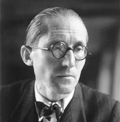
Le Corbusier (1887 – 1965)
Leader of the International Style
Le Corbusier pioneered modernism in architecture and laid the foundation for what became the Bauhaus Movement, or the International Style.
During his long life, Le Corbusier designed buildings in Europe, India, and Russia. Le Corbusier also designed one building in the United States and one in South America.
The earlier buildings by Le Corbusier were smooth, white concrete and glass structures elevated above the ground. He called these works “pure prisms.” In the late 1940s, Le Corbusier turned to a style known as “New Brutalism,” which used rough, heavy forms of stone, concrete, stucco, and glass.
The same modernist ideas found in Le Corbusier’s architecture were also expressed in his designs for simple, streamlined furniture. Immitations of Le Corbusier’s chrome-plated tubular steel chairs are still made today.
Le Corbusier is perhaps best known for his innovations in urban planning and his solutions for low income housing. Le Corbusier believed that the stark, unornamented buildings he designed would contribute to clean, bright, healthy cities. Le Corbusier’s urban ideals were realized in the Unité d’Habitation, or the “Radiant City,” in Marseilles, France. The Unite incorporated shops, meeting rooms, and living quarters for 1,600 people in a 17-story structure. Today, visitors can stay at the Unite in the historic Hotel Le Corbusier.
Distinguished work:
1927-1928: Palace for the League of Nations, Geneva
1929: Villa Savoye, Poissy, France
1931-1932: Swiss Building, Cité Universitaire, Paris
1952: The Secretariat at the United Nations Headquarters, New York